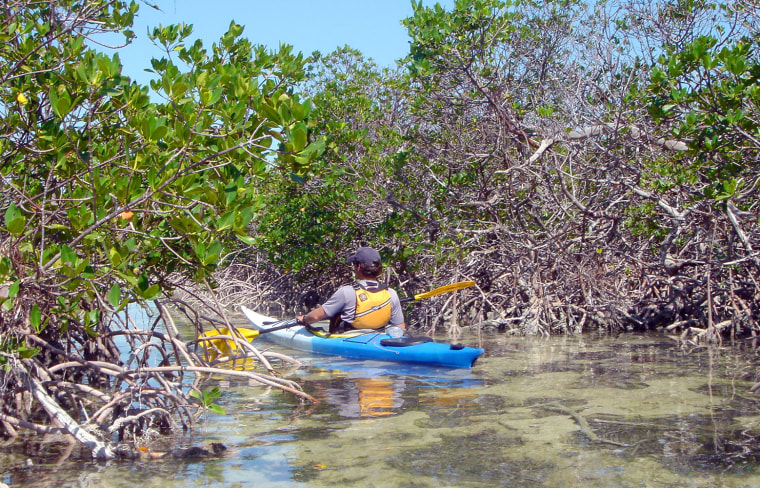Gliding slowly through the glass-clear water, I approached a clump of dark shadows about 20 feet off my bow, where a stir on the surface caught my eye.
Stingrays? Maybe. But the Florida Keys also are known for nurse, blacktip and lemon sharks, barracuda and tarpon, even American crocodiles, among hundreds of other species. Thanks to the variety and visibility, kayaking in the Keys is like floating through an aquarium.
I paddled my kayak quickly toward the gray mass and saw nurse sharks, four of them lying still on the sandy bottom. Big ones, too - nearly 5 feet long.
I was just a few feet above them on the shimmering surface, within touching distance, when they suddenly scattered, vanishing into a cloud of sand.
A few minutes later in a mangrove-lined cove tucked into the center of Raccoon Key, I was greeted by a curious spotted eagle ray, which circled my boat until several 4-foot-long blacktip sharks swept into the pool for lunch. The ray was quick to camouflage by burying its flat, winged body in the sand.
South Florida is a water lovers' playground, from Everglades National Park with its abundant alligators south to the Florida Keys.
U.S. 1 runs from the top of the island chain, near Key Largo, about 100 miles south to Key West, slicing through a tiny spit of land between the Atlantic Ocean and the Gulf of Mexico. Some 60 miles from Miami, the Keys provide a great, quick getaway from the buzz of the city.
The mostly two-lane highway is within view of water nearly the entire trip, offering numerous stop-off points for a dip, a quick snorkel, kayaking, fishing or just a lazy nap on the beach.
I drove to Cudjoe Key, about 20 miles from the end of the road in Key West, for a paddle to Raccoon Key, a great area to view nurse and blacktip sharks that favor the warm, shallow waters hugging the shoreline. Over the next six hours, I saw eight sharks.
Putting in at the tip of Cudjoe Key, I paddled out past a U.S. government facility surrounded by thick mangroves and satellite dishes - TV Marti, a Miami-based program that opposes Fidel Castro, is broadcast to Cubans from there.
It's about a mile-long open-water paddle to Budd Keys, another 2 miles to tiny Hurricane Key and on across the Gulf to my destination, Raccoon Key, an island once used as a breeding colony for rhesus monkeys.
Boston-based Charles River Laboratories, the world's largest provider of lab animals, managed the monkeys and the island for decades until the state ordered the animals removed in the late 1990s.
The monkeys were destroying the protected red mangroves and causing other problems in the Great White Heron National Wildlife Refuge. They "were beginning to escape and swim off the island," said ranger Jim Bell.
But even without the monkeys, wildlife abounds, from white herons to sharks to rays and schools of long silvery barracuda and tarpon.
My heart skipped a beat when I first saw the sharks, even though the nurse variety, which can grow up to 14 feet long and weigh more than 300 pounds, generally are not aggressive toward humans. They're nocturnal animals that typically rest on sandy bottoms or in caves or crevices in shallow waters and feed primarily on other fish.
Blacktip sharks, which can grow up to 8 feet long, are fast and more aggressive. They're known to swiftly attack schools of fish from below. According to the International Shark Attack File, blacktips are responsible for roughly 16 percent of attacks that occur in Florida waters, mostly on surfers.
"They're aggressive if there's fish in the water. You certainly can get bitten accidentally," said Jim Colvocoresses, a researcher with the Florida Fish and Wildlife Conservation Commission.
Lemon sharks, also common in the area, can grow up 12 feet long, but are of "minimal threat to humans," according to the International Shark Attack File.
The roundtrip to and around Raccoon Key is about 6.5 miles, including several fairly easy open-water stretches between islands. Landing spots are scarce given the mangrove thickets that cover the Keys, but the water tends to be only several feet deep, so kayakers can wade to stretch their legs.
Be sure to wear foot protection, though, because rays bury themselves in the sand and you can be stung if you accidentally step on one. They tend to move out of the way, however, if you shuffle or drag your feet in shallow water rather than taking steps.
If alligators are your thing, there's no better place to paddle than in Everglades National Park. It's the only place in the world where alligators and crocodiles exist together.
But keep your distance. Gators can run at up to 30 mph on land.
During a previous paddle on a several-mile loop through Noble Hammock, I saw a half-dozen gators, sometimes uncomfortably close.
My heart raced as I paddled through a narrow mangrove-covered canal. I had nearly finished the loop only to come face-to-face with a gator's head bigger than a fireplace log, his bulbous eyes floating on the water's murky surface.
I beat the boat with my paddle, slapped the water. Nothing. He just stared at me, then slowly floated toward me. I backpaddled. He kept coming. I swung the boat around, and in a frenzy, paddled furiously back the way I came. His head slowly sunk beneath the water, as I watched this long, brown shadow glide beneath me.
I once got the same thrill paddling with crocodiles and hippos in Africa, but this place is a lot closer. Even with rampant development and hordes of tourists, one can still truly get lost in the wet wilds.
On the Net:
Florida Keys: http://www.fla-keys.com/
Everglades: http://www.nps.gov/ever
